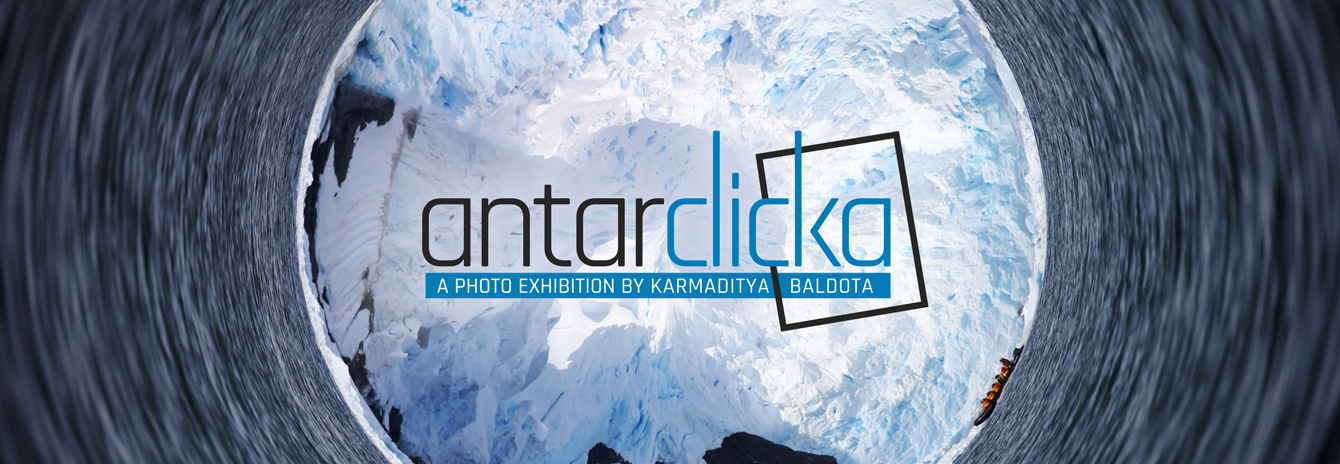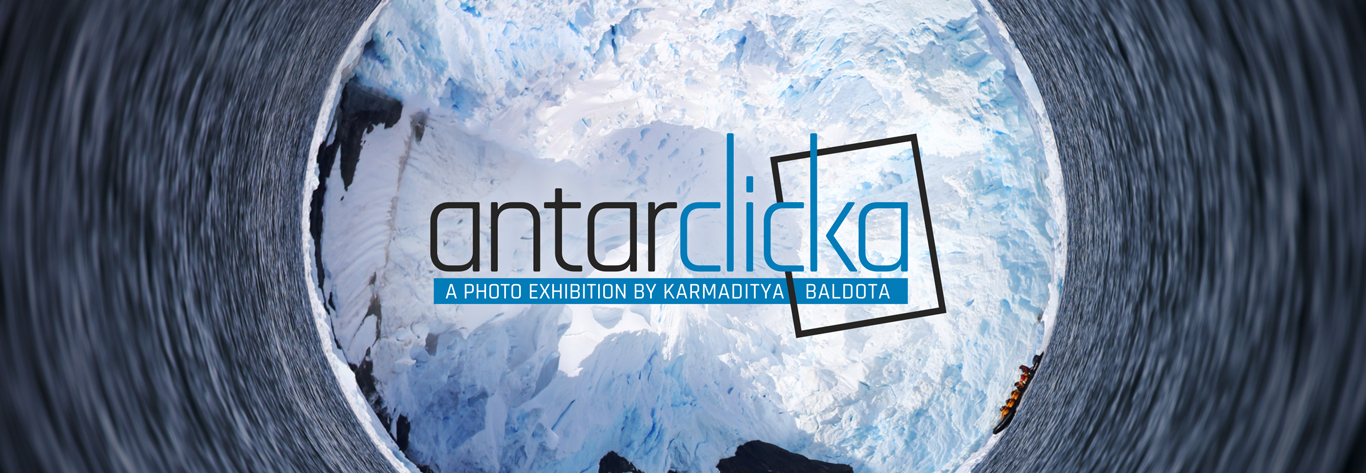
Inauguration by
British record-breaking adventurer, speaker, coach, sustainability campaigner and author.
NCPA-Piramal Art Gallery, Mumbai.
12th to 17th January, 2018
12:00 noon to 7:00 pm
Antarctica is the last and largest unspoiled wilderness area on Earth. It is a reminder of what the planet was like before the influence of man. The whole of mankind benefits from this isolated continent. Karmaditya Baldota, has captured through his lens the pristine beauty and unique marine life which includes whales breaching, seals sleeping and penguins playing. His photographs transport you to this frozen windswept continent and show you in vivid detail what we stand to lose due to climate change.

-

Ahead of the Curve
Antarclicka
Ahead of the Curve
A natural iceberg arch formation inside a tabular iceberg. Newly formed tabular icebergs have nearly vertical sides and flat tops. In the Antarctic, they may be tens of kilometers wide, up to 160 km (100 miles) long, and as much as 300 m (1000 ft) thick, with about 30 m (100 ft) exposed above the sea surface.
-

Seal of Approval
Antarclicka
Seal of Approval
Fur Seals were once hunted nearly into extinction, but have made a roaring comeback into the Antarctic. These pointy-eared polar swimmers are known to reach speeds of up to 20 km per hour on land, and can reach higher speeds while swimming. Krill makes up for 95% of their diet apart from fish, squid and penguins. Famous for their sharp eyesight and keen hearing, mother seals and pups find each other using a familiar call.
-

Waddling Away
Antarclicka
Waddling Away
Second in size only to the Emperor Penguin, these colorful divers can adapt to a wide range of weather conditions. King penguins often fight, taking away much of their energy and time. They can dive to a depth of 748 feet and stay submerged for 7 minutes. Chicks and their parents and couples find each other within noisy colonies recognizing the frequency of their vocalizations.
-

Waiting in the Wings
Antarclicka
Waiting in the Wings
Giant Petrels are the iconic birds of Antarctica. They are opportunistic feeders and can eat anything they get their bill into. They mostly feast on carrion, birds, krill, squid, and fish. These birds are quite aggressive and are known to attack other birds by either beating them to death or drowning them. The name petrel is said to be taken from the story of Saint Peter who walked on water as these birds look like they are running on water as they get ready to take flight.
-

Staring into Space
Antarclicka
Staring into Space
Adélie Penguins were discovered in 1840 on the French Antarctic expedition led by explorer Jules Dumont d’Urville. He named Adélie Land in southern Antarctica after his wife Adéle. Scientists Jacques Hombron and Charles Jacquinot attributed this name to the penguins as well. They are excellent swimmers and determined long distance walkers, especially when they have to return to their colonies traveling across many kilometers of fast ice. If the ice is covered with snow, they prefer to plonk on their bellies and slide down.
-

Spitting Feathers
Antarclicka
Spitting Feathers
The penguins’ feathers are crucial for keeping them warm and dry in the cold waters of Antarctica. They start off as a fuzzy ball of plumage and eventually develop into the majestic bird that they are. In between these two states, they undergo a phase wherein the fluffy baby feathers on their body are replaced with new adult ones. Chicks have to go through this awkward molting phase so that they can develop feathers that enable them to fledge. This process is also known as “catastrophic molt†because all the feathers are replaced at once.
-

Spoon Fed
Antarclicka
Spoon Fed
Adult penguins regurgitate their food to feed their young. The parents return to feed the chicks once every four to six weeks during the winter, leaving them to survive severe weather conditions on their own. They may lose up to 50% of their body weight while waiting for their feed. As food supplies improve in the spring, the parents return more frequently to feed. Parents are able to identify their chicks by their distinctive call and feed only their own chicks.
-

In Fine Feathers
Antarclicka
In Fine Feathers
The coloration and markings on the body separates the chicks from the adults. Scientists believe it is this coloration that elicits parental behavior from the adult penguins, and do not perceive them as competitors for mates and nesting sites. King chicks form groups known as crèches for protection from blizzards, predators and aggressive adults. As the outer edges of a crèche are most vulnerable to predation, there is an intense competition between chicks for access to the center of the group. Weaker chicks with poor health are pushed to the edges of the crèche where they are preyed upon by giant birds.
-

Stand at Ease
Antarclicka
Stand at Ease
King Penguins have been observed to be rather inquisitive and can be seen interacting with visitors by pecking or grabbing hold of their clothing and pulling on it. They display aggression and uneasiness in a number of ways. Sometimes a gyratory motion of the head precedes pecking while some flap their wings as a warning sign. In some cases a king penguin will stretch its neck towards the opponent, looking directly at it, and slightly opening its flippers in what is called the direct stare. Preening of the flippers or rubbing of head on the shoulder can indicate discomfort.
-

Mother's Call
Antarclicka
Mother's Call
Antarctic Fur Seal attends to her pup after returning from a foraging trip at the sea which lasts four or five days in South Georgia. The mother identifies her own pup by call and by detecting individual scent. Antarctic Fur Seals can walk on land, thanks to their ability to turn their rear flippers forward, turning them into useful “feet.†Unlike some other species of Seals, they are the only ones with visible ears that live in the Antarctic.
-

Blue-Eyed Piercing Stare
Antarclicka
Blue-Eyed Piercing Stare
Blue-eyed Shag characterised by the vivid eye colour gives a piercing stare to the prey in South Georgia. Blue-eyed Shags are the excellent divers with a recorded maximum dive of 116 m. Once underwater they tuck their wings in and use their powerful webbed feet to propel themselves. In the air, they can fly up to 50 km per hour.
-

Seeing Eye to Eye
Antarclicka
Seeing Eye to Eye
The eye of the Elephant Seal resembles the picture taken from the fish-eye lens. Elephant seals have large eyes, each with a spherical lens. These lenses help them adapt to darkness more quickly than any other animal yet tested, thus allowing it to hunt efficiently under the gloomy conditions at its feeding depths of between 300 and 700 meters.
-

Close Finish
Antarclicka
Close Finish
Chinstrap penguins seem to be charging towards the finishing line in a swimming competition in South Georgia. Chinstrap penguins are excellent swimmers and can swim at the speed of 20 mph. They are great divers too who can dive to depths of 230 feet. They get their name from the thin curved line of black feathers running under the chin which makes it appear as if it were wearing a black helmet.
-

My Mom's the Best
Antarclicka
My Mom's the Best
A baby Adelie Penguin spends time with mother in South Gerogia island. Like many penguins, Adélies lay two eggs of which usually only one survives to fledge. When the chick will get older and able to walk around and leave the nest, the parents will both go fishing together to supply the growing demand of food for the youngster.
-

Rarest of Rare White
Antarclicka
Rarest of Rare White
Snow Petrel is a rare sighting on land at sea level. It is one of the three species of birds that breed only in Antarctica. Their colour is purest of white and despite their diminutive size they are tough as animal needs to be to survive and even thrive in low temperatures and with a frequently high wind chill. They feed largely on krill and must always be near to the sea to feed.
-

Spyhopping
Antarclicka
-

How to Dive
Antarclicka
How to Dive
Humpback Whales show some diving skills to the tourists in Antarctic ocean. Humpback whales get the name from their habit of raising and bending the back in preparation for a dive, accentuating the hump in front of the dorsal fin. One of the larger rorqual species, adults range in length from 12–16 m (39–52 ft) and weigh about 36,000 kg (79,000 lb).
-

Smiling Assassin
Antarclicka
Smiling Assassin
Leopard Seal sunbathe atop a growler with a supposed grin on its face in the Antarctic ocean. The ends of the leopard seal’s mouth are permanently curled upward creating an illusion of a smile. However happy they may be to see you, they are dangerous predators keeping an eye out for their next meal. The second largest among all the seals, Leopard seals stretch up to 12 feet long and weigh more than 10,000 pounds.
-

Having a Whale of a Time
Antarclicka
-

A Stroll in the Park
Antarclicka
A Stroll in the Park
Chinstrap Penguins march to the beat of the waves. The narrow black band under their heads appear like a black helmet, making it one of the most easily identified types of penguin. Other common names are ‘ringed penguin’, ‘bearded penguin’, and ‘stone cracker penguin’ due to its harsh call. The last one looks like a mum waiting for her children to catch up.






















